| Columns Retired Columns & Blogs |
Jamo Reference R 907 loudspeaker Measurements
Sidebar 3: Measurements
The Jamo Reference R 907's voltage sensitivity is specified as 89dB/2.83V/m. My B-weighted estimate on the speaker's tweeter axis, with the grille removed, came in close to this, at 88dB(B)/2.83V/m. The speaker's impedance magnitude and electrical phase are shown in fig.1. Other than a dip to 3 ohms in the midbass, with a rather severe capacitive phase angle just below that region, the speaker is an easy load for the partnering amplifier to drive, with an impedance that remains greater than 7 ohms above 200Hz. (The shape of this trace will give a somewhat tilted-up response with tube amplifiers having a high source impedance, however.) The impedance traces are free from the small glitches that would indicate the presence of cabinet resonances—and, of course, the Jamo doesn't have a cabinet!

Fig.1 Jamo Reference R 907, electrical impedance (solid) and phase (dashed). (2 ohms/vertical div.)
The peak at 25Hz in the impedance-magnitude trace suggests that this is the fundamental resonance frequency of the twin, open-baffle–loaded woofers. The sum of the units' responses, measured in the nearfield, is shown as the blue trace in fig.2. The woofers behaved identically, and their combined output appears to peak between 40 and 70Hz. However, this nearfield measurement doesn't take into account the fact that the low-frequency output of an open-baffle loudspeaker will roll off in the farfield below a frequency related to the baffle's physical size. Absent the use of a large, expensive anechoic chamber, the Jamo's low-frequency output can be accurately judged only by taking in-room measurements, which I did do (see later).
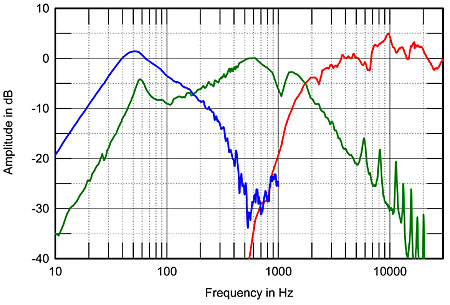
Fig.2 Jamo Reference R 907, acoustic crossover on tweeter axis at 50" without front grille, corrected for microphone response, with the nearfield responses of the midrange unit (green) and woofers (blue), plotted in the ratios of the square roots of their radiating areas below 400Hz and 1kHz, respectively.
Higher in frequency in fig.2, the crossover between the woofers and the midrange unit appears to be set at about 180Hz, a little lower than the specified 250Hz, with initially shallow rollout slopes. The midrange unit's output (green trace) peaks at 59Hz, which is presumably its open-baffle tuning frequency. The crossover to the tweeter (red) occurs at 1.8kHz rather than the specified 2.5kHz, with what looks like an 18dB/octave high-pass slope for the tweeter feed but a 12dB/octave low-pass slope for the midrange unit's rolloff. The midrange unit has some resonant spikes visible in its output above 5kHz, but these are well suppressed by the crossover. There is also a sharply defined, diffraction-related notch apparent in the midrange output at 1kHz. The tweeter's output is flat in the 3–6kHz octave, but then shelves up by 2–3dB. (This measurement was taken with the speaker's front grille removed.) The tweeter also has a well-extended ultrasonic response.
Fig.3 shows how these individual quasi-anechoic behaviors sum in the farfield. The R 907's bass response peaks in the midbass. This will be due in part to the nearfield measurement technique, but, as explained earlier, will be compensated for in-room by the dipole cancellation. The response between 300Hz and 6kHz is quite flat, but disturbed by the 1kHz suckout noted earlier, with then the top two octaves shelving up.
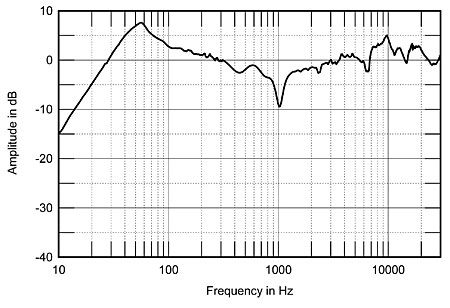
Fig.3 Jamo Reference R 907, anechoic response on tweeter axis at 50" without front grille, averaged across 30° horizontal window and corrected for microphone response, with the complex sum of the midrange and woofer nearfield responses plotted below 300Hz.
Figs. 4 and 5 show the Jamo's lateral dispersion referenced to the tweeter-axis response, first with the actual responses shown at 5° intervals to the speaker's sides (fig.4), then with the tweeter-axis response subtracted from each (fig.5). The 1kHz notch quickly fills in to the speaker's sides, which suggests that it may well not be readily audible. The midrange unit doesn't show much in the way of dipolar behavior within its passband, which perhaps explains KR's feeling that the soundstage was confined to within the speaker positions. To the left of these graphs (which stop at 300Hz), however, you can see the start of the woofer's dipole cancellation notch. (Standing to the speaker's side so that one ear receives the frontal radiation and the other the rear radiation produces an uncomfortable out-of-phase effect at low frequencies, which reveals the efficacy of the dipole principle.) The upper-frequency dispersion is quite wide and even, at least until 6kHz, above which it narrows with increasing frequency, though the tweeter still maintains its off-axis output in the top octave to 15° on either side. In the vertical plane (fig.6), the on-axis notch starts to fill in for lower listening axes but worsens for standing listeners. Other than that, the R 907 maintains its upper-frequency balance over a wide vertical angle.

Fig.4 Jamo Reference R 907, lateral response family at 50", from back to front: response 90–5° off axis, reference response on HF axis, response 5–90° off axis.
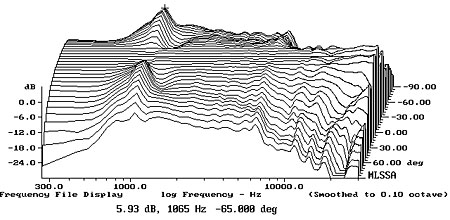
Fig.5 Jamo Reference R 907, lateral response family at 50", normalized to response on tweeter axis, from back to front: differences in response 90–5° off axis, reference response, differences in response 5–90° off axis.

Fig.6 Jamo Reference R 907, vertical response family at 50", normalized to response on tweeter axis, from back to front: differences in response 15–5° above axis, reference response, differences in response 5–15° below axis.
Kal Rubinson mentioned that the R 907 sounded too bright with its front grille removed. Fig.7 shows the Jamos' spatially averaged response at the listening seat in my room with the speakers' front grilles in place (blue trace) and removed (red). (The rear grilles were left on.) The treble is actually a little flatter without the grilles, but the grilles do drop the presence region by as much as 3dB. As this is where the ear is most sensitive, I expect that this is why KR preferred the sound with the grilles in place, rather than the slight shelving-down of the top two octaves that also occurs with the grilles in place. There is no trace of the on-axis suckout at 1kHz, and the Jamos' overall in-room response is impressively even. Other than the peaks and dips between 30 and 400Hz—room acoustic effects that have not been completely eliminated by the spatial averaging—the Jamos' lower-frequency output in-room can be seen to extend to 25Hz at full level, below which it rolls off quite rapidly. As Kal noted, this is impressive bass extension for a dipole design.
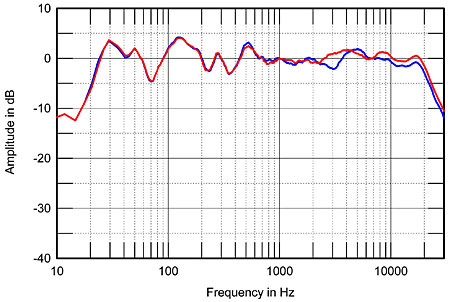
Fig.7 Jamo Reference R 907, spatially averaged, 1/6-octave response in JA's listening room with (blue) and without (red) front grilles.
Fig.8 shows the R 907's farfield step response on the tweeter axis. The sharp initial spike is the tweeter's output, which neatly integrates with the negative-going step of the midrange unit. The positive-going decay of this driver's step then smoothly hands over to the slow, positive-going rise of the woofers' step. The excellent time-domain integration of the drive-units' outputs, made possible by inverting the polarity of the midrange unit, correlates with the equally good frequency-domain integration seen in fig.3. Finally, the R 907's farfield cumulative spectral-decay plot (fig.9) shows a relatively clean initial decay, but with some delayed energy apparent at the frequency of the on-axis suckout at 1kHz (which suggests that this is a cancellation effect of some kind), as well as at 7kHz, where the tweeter output shelves upward.

Fig.8 Jamo Reference R 907, step response on tweeter axis at 50" (5ms time window, 30kHz bandwidth).
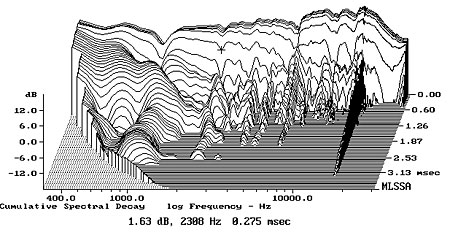
Fig.9 Jamo Reference R 907, cumulative spectral-decay plot on tweeter axis at 50" (0.15ms risetime).
The Jamo Reference R 907 offers respectable measured performance, and its low frequencies are surprisingly extended in-room. But as Kal Rubinson noted, it really should be used with its front grille in place if it is not to sound a little bright.—John Atkinson
- Log in or register to post comments




































